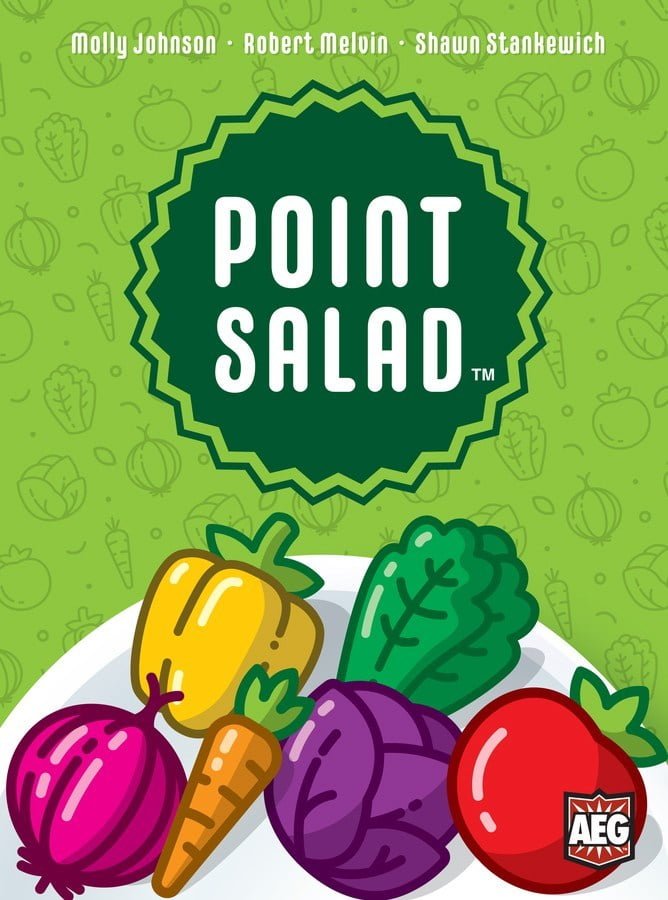Time to chop up some colorful veggies and toss together a salad—Point Salad!
What Is Point Salad?
Point Salad is a card-drafting game for 2 to 6 players, ages 14 and up, and takes about 15–30 minutes to play. It was one of AEG’s Big Game Night titles, and is available this month for purchase at game stores and through AEG, with a retail price of $19.99. Although the box says “14+” for the age recommendation, the gameplay is actually quite simple. Scoring will require a good bit of arithmetic—not difficult, just many things to keep track of—so that’s all that is really needed to be able to learn the game.
 Point Salad is GeekDad Approved!
Point Salad is GeekDad Approved!
Point Salad Components
Point Salad comes with 108 cards. That’s it! Each card is double-sided, with a scoring rule on one side, and a vegetable on the other. The scoring side also has icons in the corners indicating what vegetable is on the reverse. There are six different vegetables (18 cards of each), but every scoring rule is unique.
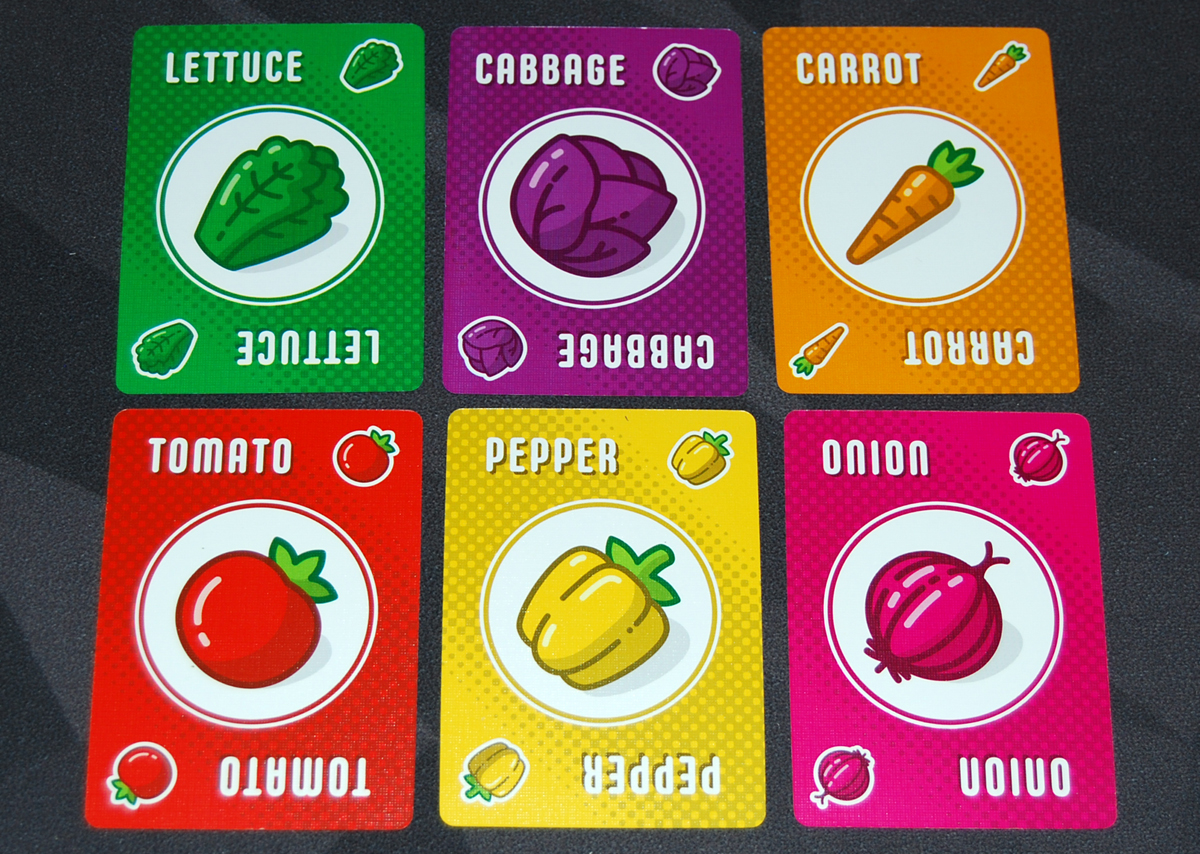
The cards are nice, with a linen finish, and the vegetable graphics by Dylan Mangini are colorful and eye-catching. The scoring rules on the backs of the cards are also, for the most part, self-explanatory.
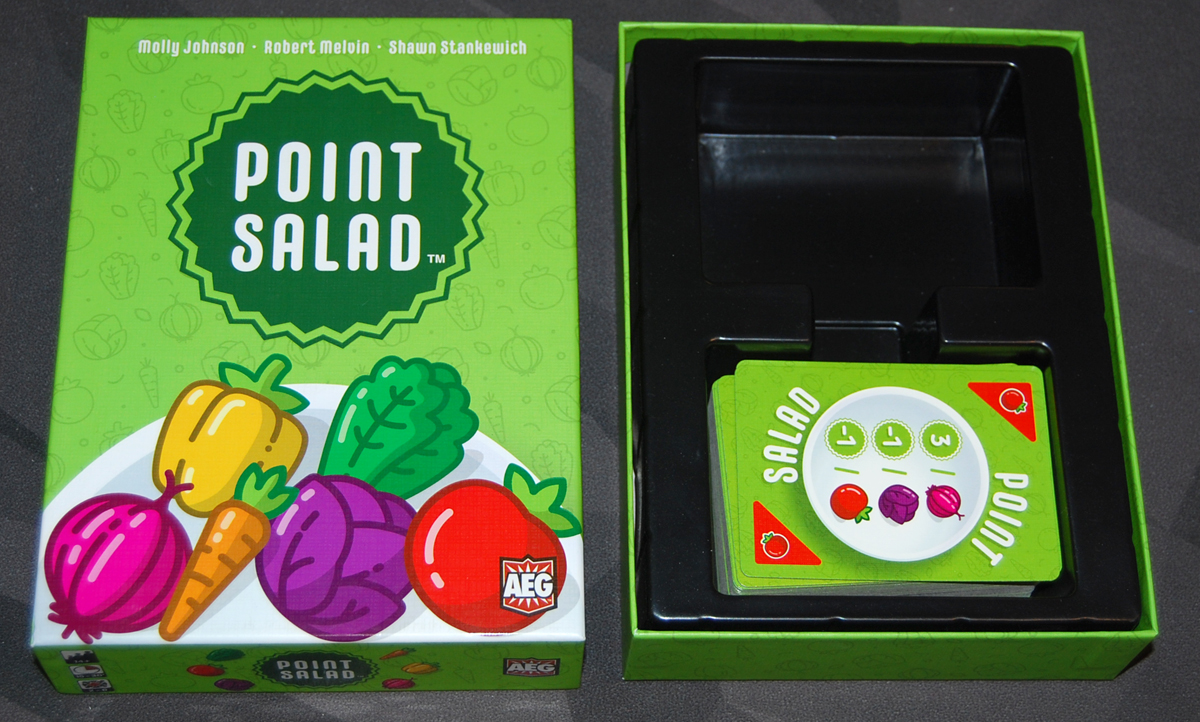
My only complaint (as usual) is the box size. For a game that is essentially 2 decks of cards, it comes in a pretty substantial box. The box isn’t huge, but this is a game that could just about fit in my pocket and be very portable if it were in a smaller box. I put the cards into my Quiver case for Gen Con because it just didn’t make sense to carry the box around.
How to Play Point Salad
You can download a copy of the rulebook here.
The Goal
The goal of the game is to score the most points by collecting vegetables that match up to your scoring cards.
Setup
Setup is pretty simple. If you have fewer than 6 players, you’ll have to remove a few sets of vegetables, but otherwise you just shuffle the whole deck.
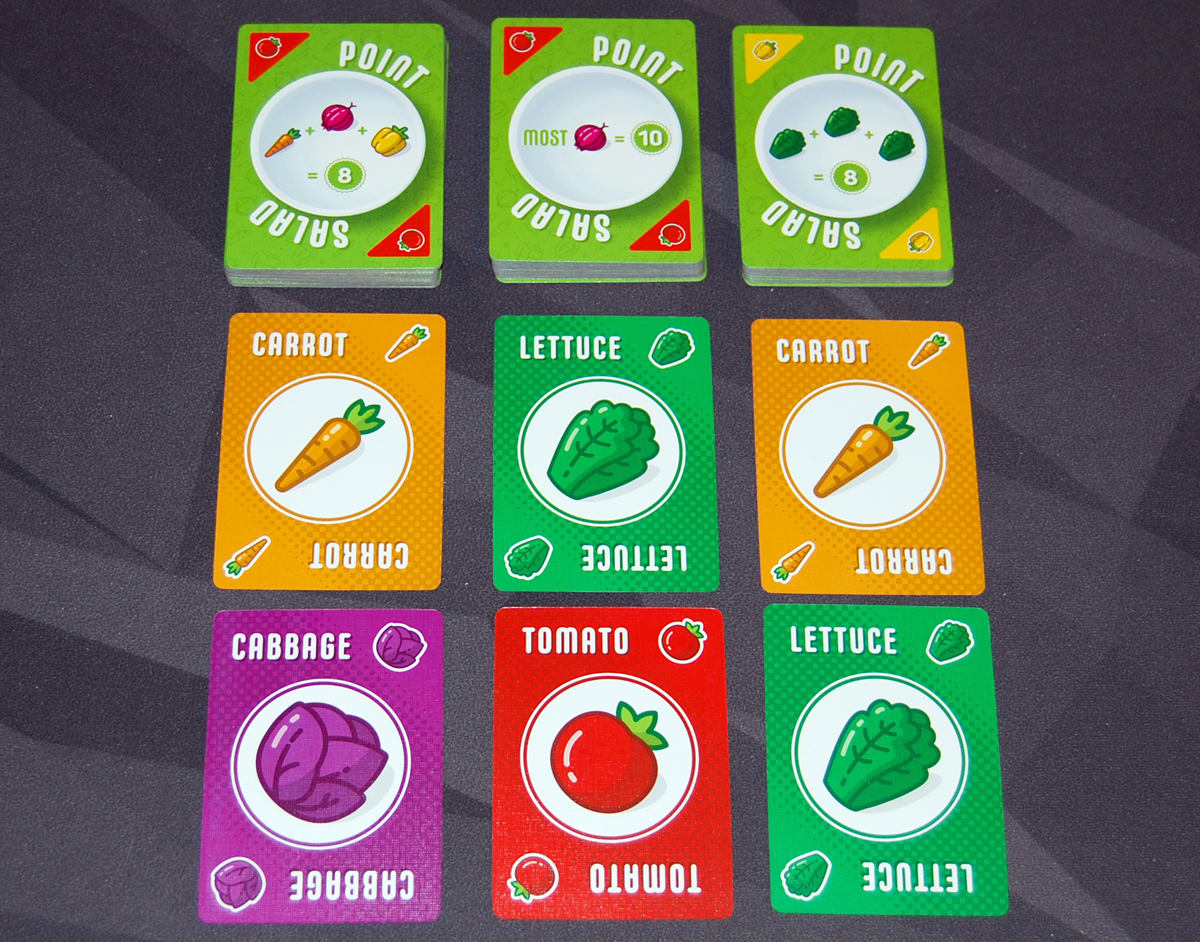
Divide the deck into three piles, with the scoring side up. Then turn over the top two cards of each pile, forming three columns of cards.
Gameplay
Players take turn in clockwise order. On your turn, you must take either a scoring card from the stacks, or any two vegetable cards. If you take veggies, fill in the empty slots with cards from the corresponding stack.
You may optionally flip one of your score cards (even one you just took this turn) over to its veggie side. Note that you cannot flip a veggie back over to its scoring side.
Game End
The game ends when all of the cards, both veggies and point cards, have been taken.
Now the fun begins: the arithmetic!

Each of your scoring cards is totaled up individually, so the same vegetable card could count for (or against) multiple scoring cards. In the photo above, my scoring cards from left to right are:
- 2 missing veggie types x 5 = 10 points
- I had the most cabbage = 10 points
- 3 onion + pepper sets x 5 = 15 points
- I did not have the fewest total veggies = 0 points
- 2 pairs of peppers x 5 = 10 points
My total score is 45 points.
Add up your total score—the highest score wins. (No tiebreaker rule is provided.)

Why You Should Play Point Salad
In case you’re not familiar with the phrase, “point salad” is often used to describe games that have a lot of different ways to score points, and it’s not generally used as a compliment. In those cases, the complaint is that there are so many avenues for scoring points that it can feel hard to form a strategy. Point Salad takes that concept and runs with it, and the result is surprisingly delicious.
Don’t be fooled by the short components and rules section of this review—although it doesn’t look like much, Point Salad has been a hit at my gaming group. One playthrough can be a great filler game in between meatier courses, but you can also play a few times in a row as a main course, if you like. The game just clicks really well—the rules are easy to pick up, but then the various scoring combinations lead to some nice puzzles as you try to maximize your score (or, failing that, minimize somebody else’s).

Since every card in Point Salad has a scoring rule on the back, you have countless ways to score points. The more score cards you take, the more things you have to keep track of. One card may give you points for carrots, and then another card has a penalty for carrots, while yet another one will give you a bonus if you have an even number of carrots. But, of course, if all you take is scoring cards, then you’re not going to have a lot of vegetables to fulfill those requirements. Some cards do award points for having the fewest of something, so it is possible to score points with no vegetables at all, but it can be difficult.
On the flip side, if you take a lot of vegetables but no scoring cards, you will score nothing at all, even if you have the most of everything. The trick is knowing how to get scoring cards and vegetables that line up nicely. If you take vegetables first, then you may get stuck with veggies that actually cost you points based on a card you take later. If you take a scoring card first, chances are that other players will snap up those veggies before you get to them, simply to keep you from scoring. It’s particularly painful when you see a scoring card that matches up with several vegetables that are currently available: you know you’re only going to get one or the other. Hate-drafting—taking a card that you know somebody else wants—is definitely a common tactic in Point Salad.
Because of the way that the vegetable area refills, there’s another way to hate-draft, too: if you see a scoring card that another player would really benefit from but you don’t want it yourself, you can also just take a vegetable from that column, because then the scoring card flips over to refill the space and becomes a vegetable. In many drafting games, you’re stuck taking things that you don’t want to keep somebody else from getting it, but here there’s an alternative.
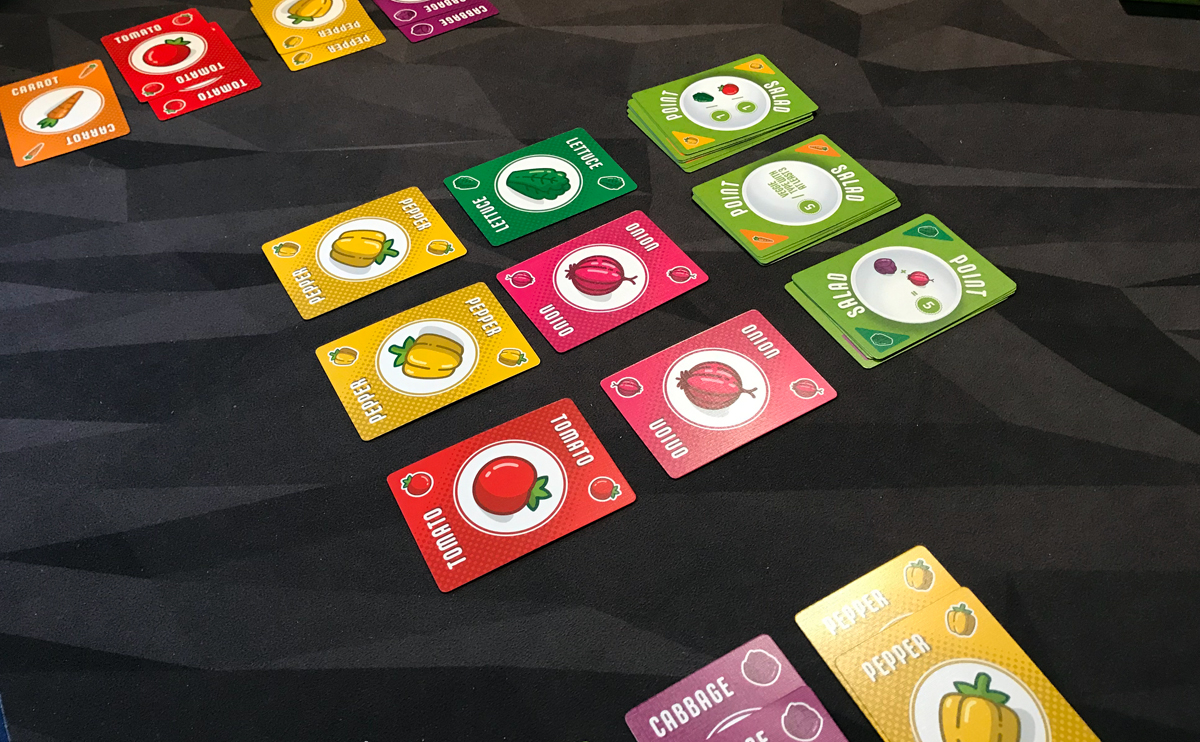
I also like that you can play up to six players, because sometimes it can be hard to find games for that many players that aren’t party games. With more players, it can be a little more chaotic—you’re guaranteed that by the time it’s your turn again, none of the scoring cards will be the same again. It’s still not heavy strategy, so if you prefer hour-long games that require more long-term planning, it may not be what you’re looking for. But if you enjoy card-drafting and set collection, Point Salad puts a fun spin on the genre, and requires at least a bit of strategic thinking.
I first got to try out Point Salad in prototype form a few years ago at GameStorm and really enjoyed it. The finished game is fairly similar to what I’d played then, and I was excited when I heard that AEG would be publishing it. It turned out really nicely, and is one that I liked enough to take with me to Gen Con to share with friends. It’s a slick little game that, as simple as it seems on the surface, is still pretty satisfying to play.
Click here to see all our tabletop game reviews.
![]() To subscribe to GeekDad’s tabletop gaming coverage, please copy this link and add it to your RSS reader.
To subscribe to GeekDad’s tabletop gaming coverage, please copy this link and add it to your RSS reader.
Disclosure: GeekDad received a copy of this game for review purposes.
